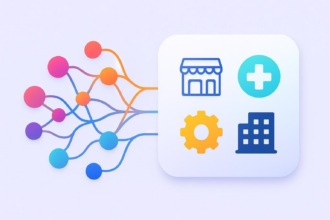Evolution is a slow but mighty process, whether you’re observing finches in the Galápagos Islands or changes in your company. Seemingly small changes add up over time until the end result is completely different from the original. Understanding workplace evolution can help small business owners prepare for future growth while avoiding getting stuck in the past.
Check it out…
Create powerful HR forms for free with Jotform. Collect employee feedback, onboard new hires, and explore new ways to automate your HR workflow.
Though there are many examples of workplace evolution, we can divide the most important changes into four main categories: technology, workplace environment, employee satisfaction, and employee wellness.
BambooHR conducted a study that examined how the workplace has changed in these four areas. The study covered workplace evolution from 2006 to 2016, a window that began before smartphones and ended after the Great Recession. As you consider how to manage changes in the workplace, compare how these four areas changed in your organization during the same 10-year period and how things may have shifted during the last three years.
Technology
Changes in the workplace due to technology often have the most profound and far-reaching effects. After a brief stay on the cutting edge, new technology integrates so deeply into our lives that it becomes difficult to remember life before it.
Case in point: My wife watched an old movie with a youth group recently. Since all of the kids were too young to remember life before smartphones, the adults in the room provided a helpful commentary. “That’s a phone he’s dialing. And that’s a newspaper. And he’s putting the newspapers in bags to do what was called a paper route.”
Now imagine a parallel workplace conversation: “Making a copy? We called that xeroxing. We made sure to print enough so that everyone had their own copy to read during the sync meeting. Everyone needed their own notepad and pen.”
The questions in the BambooHR study illustrate some workplace technologies that have gone the way of xeroxing and paper routes. The 2006 data shows that a large majority of companies used
- Internet monitoring (76 percent)
- Site blocking (65 percent)
- Email monitoring (55 percent)
- Email regulation policies (76 percent)
Each of these measurements dropped by more than half in the 2016 data, possibly because employees gained Internet-connected smartphones that made the restrictions meaningless. And if the point behind these technologies was to limit personal interactions during work hours, then the shift in focus away from email might be due to the social media explosion that happened around 2010 with the launch of Instagram and the LinkedIn IPO.
Implications for workplace evolution
Instead of controlling employees with unenforceable technological constraints, effective workplaces use technology to smooth out processes and support the communication needed for effective company culture.
Workplace environment
It’s no accident that the technological advances listed above mainly deal with communication. While technology helps bring advances in every field, technological advances in communication provide the most universal changes in the world of work.
But with all of these changes, one thing remains the same: Most employees benefit from a separation between work and home. The data from the survey back this up: 79 percent of respondents in 2016 felt that they still accomplished their best work at the office (down from 84 percent in 2006). But that 5 percent didn’t go home — the survey data suggest that they went to connected places in society, such as coffee shops and libraries.
As the job market tightens, many companies are going further afield in their search for talent. These remote workers now want the capacity to connect with their organizations while having in-person interactions. This trend shows in the rise of coworking spaces, or office space where freelancers and employees alike can work, mingle, network, and develop their skills. Some estimates predict that the U.S. will have more than 5,000 coworking spaces by the end of 2019.
Implications for workplace evolution
Effective workplaces do more than ensure employees have a working computer with the right software and an internet connection (although covering these steps during onboarding is also important). Effective workplaces use online tools to ensure that employees have an environment where they can focus, collaborate, communicate, and produce, regardless of how close they are geographically to the main office.
Wellness and balance
As the workplace changes, employees experience both an opportunity and a danger. Improved technology can lead to greater efficiency at work and more time at home — or it can intrude into daily life as employees face “always-on” expectations.
The data from the survey shows that we’ve made progress in this regard. Only 10 percent of respondents reported feeling stressed on a daily basis in 2016, a sharp decline from the 40 percent reported in 2006. What’s more, the top reasons for this stress shifted from deadlines and interpersonal relationships (in 2006) to dealing with problems and staff management (in 2016).
Correlation isn’t causation, but it’s fascinating to see a workplace evolution where a reduction in stress accompanies a shift away from focusing on deadlines. Today, perhaps organizations are more worried about getting the job done right versus getting it done “on time,” and without the artificial pressure from imposed deadlines and technology-limited interpersonal communication, stress seems to have dropped as a result.
Implications for workplace evolution
Instead of a culture that focuses on consequences for employees who miss deadlines, create a culture that provides effective feedback between management and employees. Making open feedback a part of regular performance management can free employees and managers to focus on real improvement instead of beating the buzzer with another all-nighter.
Employee satisfaction
The previous three areas of workplace change likely intertwine with the fourth: employee satisfaction. The survey reports the following:
- A 7 percent increase in employees who think their manager is an effective leader
- A 16 percent increase in employees who feel they’re receiving effective recognition
- A 17 percent increase in employees who are satisfied with their workload
- An 8 percent increase in employees who feel their organization supports work-life balance
Considering these advancements, it’s not too surprising that there was a 21 percent increase in employees who would choose a job with their current employer over a similar job with a different employer.
Implications for workplace evolution
Instead of simply hiring an employee to fill a job, develop a succession plan for your company’s growth. Where will your business be in five years? What skills will you need? Who will provide them? LinkedIn’s 2018 Workplace Learning Report found that 94 percent of employees would stay at their current workplace longer if it offered opportunities for growth and development.
Help your workplace change for the better
All four of these areas of workplace evolution have one thing in common — they’re all aspects of developing an effective company culture. While there are many definitions of company culture, I prefer this one:
Company culture is the summation of how people within an organization interact with each other and work together.
Streamlining communication with technology, creating a workplace environment that promotes interaction, and creating a management plan that delivers employee wellness and satisfaction are all practices that lead to effective company culture, no matter your industry or business. Developing this kind of strategic workplace will help your business survive and thrive as it continues into the future.
Check out the BambooHR Blog for more on implementing a more effective company culture.












Send Comment: